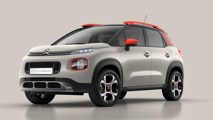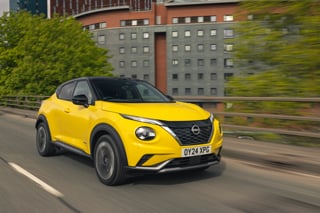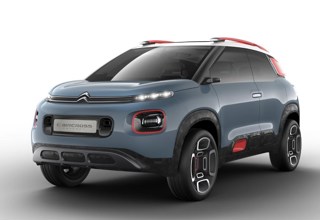Review
Citroën's small SUV, the Aircross, has plenty of features for drivers seeking something distinctive.
The small SUV market is booming – both in terms of registrations and the number of different vehicles in the sector. In the UK, B-segment registrations have risen 50% since 2014 and are expected to increase another 40% by 2020.
Across Europe, they are expected to double from 1.1 million in 2016 to 2.2m by 2020.

This surge in interest has benefited models such as the Nissan Juke – the current Fleet News Awards small SUV of the year – and the Renault Captur.
In addition, a growing number of manufacturers are preparing to enter the market with the Volkswagen T-Roc, Kia Stonic, Hyundai Kona and Seat Arona among those on the way.
Another new arrival is the Citroën C3 Aircross, which is on sale now with first deliveries taking place next month (November).
Taking many of its styling cues from the bold C4 Cactus, the C3 Aircross is attractive, rugged and distinctive.
The two-tier front lights remain, but an obvious omission is the airbump-cushioned body protection which was such a large part of the C4 Cactus: designers felt their inclusion would make the C3 Aircross appearance too cluttered.
Even without them, protective skid plates at the front and rear, and black plastic wheel arches help give the C3 Aircross a rugged look, while its raised ride height (it has a ground clearance of 17.5cm, 2cm more than the C3 supermini on which it is based) adds to this.
The model is available with a choice of five engines – 82PS 1.2-litre petrol; 110PS 1.2-litre petrol; 130PS 1.2-litre petrol; 100PS 1.6-litre diesel; and 120PS 1.6-litre diesel. Plus there are three trim levels, Touch, Feel and Flair.
CO2 emissions begin at 104g/km for the 110PS 1.6-litre BlueHDi diesel models and it is this powertrain option, together with the 110PS 1.2-litre PureTech petrol producing 115g/km of CO2, which will have most fleet appeal.
Official combined fuel economy is 70.6mpg for the 110PS 1.6 BlueHDi and 56.4mpg for the 1.2 PureTech model, and both sit in the 22% benefit-in-kind (BIK) tax bracket, which gives a 20% taxpayer an annual bill of £749 for the diesel model and £703 for the petrol (Feel trim).
Touch equipment grade is available only with the 82PS 1.2-litre petrol engine, and features 16-inch steel wheels, split rear folding seats, digital radio with Bluetooth connectivity, lane departure warning, remote central locking, cruise control, air conditioning and automatic lights.
Feel adds 16-inch alloy wheels, LED daytime running lights, fog lights with cornering function, Mirror Screen with Android Auto, Mirror Link and Apple CarPlay, seven-inch touchscreen, electrically adjustable and heated door mirrors, and privacy glass.
Flair adds 17-inch alloy wheels, bi-tone roof, a style pack in a choice of four colours, Citroën Connect Box emergency and assistance system, satellite navigation, dual zone air conditioning, rear parking sensors, keyless entry and start, and a sliding 60/40 split folding rear bench seat.
P11D prices range from £13,870 for the 1.2-litre 82PS Touch model to £19,525 for the 1.6 BlueHDi 120 Flair.
Citroën expects to register 14,000 C3 Aircross models in the UK next year, with 45% going to fleet.
C3 Aircross is available only with front-wheel drive, although the manufacturer’s GripControl technology is offered as a £400 option if drivers want to increase their off-road capability.
This allows drivers to select tailored modes for different driving conditions to increase traction. It also includes hill descent assist.
However, for most drivers this will be an unnecessary expense, as they will spend almost all of their time on the tarmac – a surface the C3 Aircross impresses on.
Its ride and handling dynamics are set up for comfort over sportiness, which means the SUV offers a smooth ride with only some really poor road surfaces upsetting its composure.
The 110PS petrol engine is refined, providing plenty of low-end power, while the C3 Aircross also offers an impressive amount of practicality.
There is plenty of room inside for four six-footers, and its 410-litre boot sits in the middle of the sector: the Juke offers 354 litres and the Captur 455.
However, this rises to 520 litres on the C3 Aircross if the spilt folding rear seats are slid forward – part of a £490 family pack on Feel trim level and standard on Flair.
The cabin is largely unchanged from that in the C3 supermini, which means it features many of the new Citroën design cues and feels well built, although there are some hard plastics on view.
However, as an overall package the C3 Aircross impresses.
Despite the increasingly competitive nature of the sector, its styling and all-round ability means it should offer plenty of appeal to company car drivers looking for something distinctive.
Model tested: Citroen C3 Aircross 1.2 110PS Feel
Specs
| Manufacturer | Citroen |
| Model | C3 Aircross |
| Specification | C3 Aircross SUV 1.2 PureTech 110 SS €6 Feel 17.75MY |
| Model Year | 0.00 |
| Annual VED (Road tax) | £0 |
| BIK List Price | £15,985 |
| CO2 | 115g/km |
| BIK Percentage | 22% |
| Insurance Group | N/A |
| CC | N/A |
| Fuel Type | Petrol |
| Vehicle Type | SUV and Crossover |
| Luggage capacity (Seats up) | 5litres |
Running Costs
| P11D | £15,985 |
| Insurance group | N/A |
| Fuel Type | Petrol |
| Cost per mile | 52.04ppm |
| Fuel | 9.43ppm |
| Depreciation | 41.30ppm |
| Service maintenance and repair | 1.31ppm |
Rivals
Info at a glance
-
P11D Price
£15,985
-
MPG
56.5 -
CO2 Emissions
115g/km -
BIK %
22% -
Running cost
3 Year 60k : N/A 4 Year 80k : N/A -
Fuel Type
Petrol

















 Petrol
Petrol




















